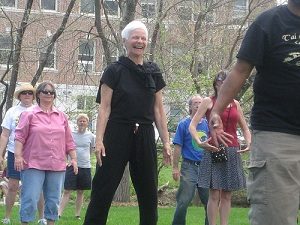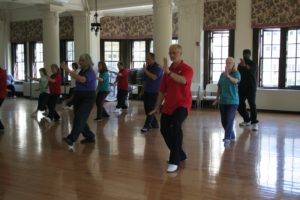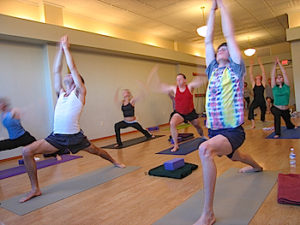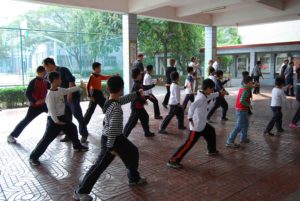Improve the Symptoms of COPD with Mindful Movement Practices
By John M. de Castro, Ph.D.
“a low-cost exercise intervention is equivalent to formal pulmonary rehabilitation, and this may enable a greater number of patients to be treated. Physical activity is key to reducing symptoms in COPD. We do recommend [pulmonary rehabilitation], but our study shows that tai chi is a viable alternative when there is no local [pulmonary rehabilitation] service.” – Yuan-Ming Luo
Chronic obstructive pulmonary diseases (COPD) are progressive lung diseases that obstruct airflow. The two main types of COPD are chronic bronchitis and emphysema. COPD is very serious being the third leading cause of death in the United States, over 140,000 deaths per year and the number of people dying from COPD is growing. More than 11 million people have been diagnosed with COPD, but an estimated 24 million may have the disease without even knowing it. COPD causes serious long-term disability and early death. Symptoms develop slowly. Over time, COPD can interfere with the performance of routine tasks and is thus a major cause of disability in the United States. The most common cause of COPD is smoking. But, COPD also occurs with miners and is called black lung disease. COPD is not contagious. Most of the time, treatment can ease symptoms and slow progression.
There is no cure for COPD. Treatments include lifestyle changes, medicine, bronchodilators, steroids, pulmonary rehabilitation, oxygen therapy, and surgery. They all attempt to relieve symptoms, slow the progress of the disease, improve exercise tolerance, prevent and treat complications, and improve overall health. Gentle exercise such as Yoga practice could improve COPD symptoms as it has been shown to improve exercise tolerance and overall health and includes breathing exercises. Indeed, it has been shown that yoga practice improves the mental and physical health of patients with COPD. Mindful Movement practices such Tai Chi and qigong are ancient Chinese practices involving mindfulness and gentle movements. They are easy to learn, safe, and gentle. So, it may be appropriate for patients with COPD who lack the ability to engage in strenuous exercises to engage in these gentle practices.
In today’s Research News article “Effectiveness of meditative movement on COPD: a systematic review and meta-analysis.” (See summary below or view the full text of the study at: https://www.ncbi.nlm.nih.gov/pmc/articles/PMC5909800/ ), Wu and colleagues review and summarize the published literature on the use of yoga practice or Tai Chi and qigong (meditative movements) for the treatment of Chronic obstructive pulmonary diseases (COPD). They discovered 16 studies of which 7 evaluated yoga, 4 tai chi, 3 qigong, and 2 tai chi and qigong combined. The studies involved 1176 total COPD patients.
They found that the studies reported that COPD patients who engaged in meditative movements were able to walk further in 6 minutes than controls even when the control condition was walking exercise. Further meditative movement was reported to significantly improve lung function and quality of life with COPD and reduce fatigue. Hence the published literature supports the use of meditative movements, yoga, Tai Chi and Qigong, for the treatment of the symptoms of Chronic obstructive pulmonary diseases (COPD).
These findings are particularly important as mindful movement practices, are gentle and safe, having no appreciable side effects, they appropriate for all ages including the elderly and for individuals with illnesses that limit their activities or range of motion, are inexpensive to administer, can be performed in groups or alone, at home or in a facility, and can be quickly learned. In addition, they can be practiced in social groups. This can make it fun, improving the likelihood of long-term engagement in the practice. So, the mindful movement practices of yoga, Tai Chi and Qigong would appear to be almost ideal, safe and effective treatments for the symptoms of Chronic obstructive pulmonary diseases (COPD).
So, improve the symptoms of COPD with mindful movement practices.
“Finding a way to relieve stress when dealing with COPD is key to sustaining good health. Tai Chi is an easy, graceful exercise that is highly effective for reducing stress levels.” – Lung Institute
CMCS – Center for Mindfulness and Contemplative Studies
This and other Contemplative Studies posts are also available on Google+ https://plus.google.com/106784388191201299496/posts and on Twitter @MindfulResearch
Study Summary
Wu, L.-L., Lin, Z.-K., Weng, H.-D., Qi, Q.-F., Lu, J., & Liu, K.-X. (2018). Effectiveness of meditative movement on COPD: a systematic review and meta-analysis. International Journal of Chronic Obstructive Pulmonary Disease, 13, 1239–1250. http://doi.org/10.2147/COPD.S159042
Abstract
Background
The effectiveness of meditative movement (tai chi, yoga, and qigong) on COPD remained unclear. We undertook a systematic review and meta-analysis to determine the effectiveness of meditative movement on COPD patients.
Methods
We searched PubMed, Web of Science, EMBASE, and the Cochrane Center Register of Controlled Trials for relevant studies. The methods of standard meta-analysis were utilized for identifying relevant researches (until August 2017), quality appraisal, and synthesis. The primary outcomes were the 6-minute walking distance (6MWD), lung function, and dyspnea levels.
Results
Sixteen studies involving 1,176 COPD patients were included. When comparing with the control group, the 6MWD was significantly enhanced in the treatment group (3 months: mean difference [MD]=25.40 m, 95% CI: 16.25 to 34.54; 6 months: MD=35.75 m, 95% CI: 22.23 to 49.27), as well as functions on forced expiratory volume in 1 s (FEV1) (3 months: MD=0.1L, 95% CI: 0.02 to 0.18; 6 months: MD=0.18L, 95% CI: 0.1 to 0.26), and FEV1 % predicted (3 months: 4L, 95% CI: 2.7 to 5.31; 6 months: MD=4.8L, 95% CI: 2.56 to 7.07). Quality of life for the group doing meditative movement was better than the control group based on the Chronic Respiratory Disease Questionnaire dyspnea score (MD=0.9 units, 95% CI: 0.51 to 1.29) and fatigue score (MD=0.75 units, 95% CI: 0.42 to 1.09) and the total score (MD=1.92 units, 95% CI: 0.54 to 3.31).
Conclusion
Meditative movement may have the potential to enhance lung function and physical activity in COPD patients. More large-scale, well-designed, multicenter, randomized controlled trials should be launched to evaluate the long-range effects of meditative movement.
https://www.ncbi.nlm.nih.gov/pmc/articles/PMC5909800/






